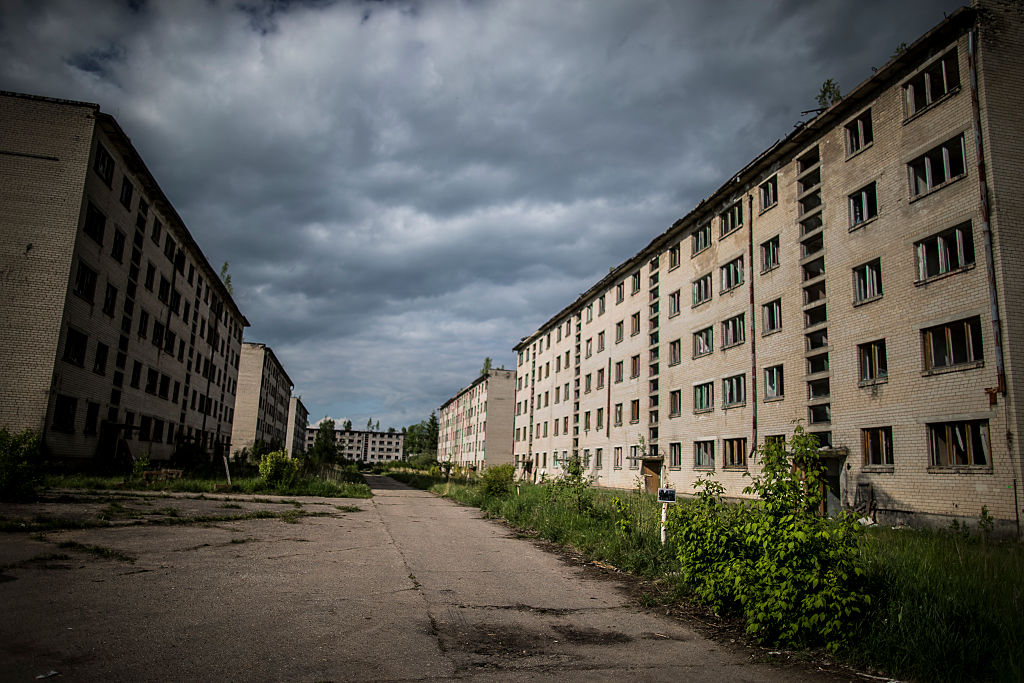IN the heart of Latvia’s dense forests lies the ghostly remains of an abandoned Soviet town that once stood as a secret sentinel of the Cold War era.
Conceived in the tense atmosphere of the 1960s, Skrunda-1 was built to house the operators of an early warning radar system, designed to detect incoming missiles from the West.
For decades, the clandestine city was shrouded in secrecy, with its very existence denied by Soviet authorities.
At its peak, Skrunda-1 was a bustling, self-contained community with everything a small city might need: schools, shops, a hospital and apartment buildings.
Yet, this wasn’t a city of typical civilians.
Its residents were all military personnel and their families, living under constant surveillance and strict regulations in true Soviet fashion.
More on abandoned Soviet towns
Life in Skrunda-1 revolved around the giant radar towers that loomed over the city, their antennas sweeping the Russian skies in an unending quest for potential threats.
The heart of Skrunda-1 was its radar systems, most notably the Dnepr radar, a colossal structure that dominated the skyline.
The radar emitted a constant, low hum, a reminder of the city’s primary purpose.
At night, the eerie glow of lights from the radar installations gave the city an otherworldly aura, casting long shadows over the deserted streets and the surrounding forest.
Most read in The Sun
In 1991, the dissolution of the Soviet Union marked the beginning of the end for Skrunda-1, some 150 km from capital city Riga.
As Latvia regained its independence, the once tightly controlled secrets of the city began to unravel.
The Russian military continued to operate the radar station until 1998, but as geopolitical realities shifted, Skrunda-1’s importance dwindled.
Finally, in a symbolic act marking the end of an era, the radar towers were demolished.
Left to rot, Skrunda-1 began its slow descent into oblivion.
Shocking pictures show nature reclaiming the city, weeds sprouting through cracks in the concrete, and trees growing in what were once playgrounds and courtyards.
The sterile buildings, once filled with dozens of families, now stand silent, their broken windows staring out at the never-ending forest.
Despite its abandonment, Skrunda-1 has not been entirely forgotten.
Urban explorers and history enthusiasts occasionally venture into the crumbling remains, drawn by the eerie stillness and the palpable sense of history.
The empty buildings are filled with relics of the past: children’s toys, old uniforms, and faded propaganda posters.
Each artefact tells a story of the lives that once intertwined in this secluded corner of the world.
Walking through Skrunda-1 today feels like stepping into a post-apocalyptic world.
The silence is profound, broken only by the occasional rustle of leaves or the distant call of a bird.
The air is thick with a sense of loss, a lingering ghost of the Cold War that once gripped the world in its icy grasp.
Skrunda-1 remains a haunting monument to a bygone era, a place where time seems to stand still, preserving the memories of those who once lived and worked in its shadows.
Meanwhile, hidden in the middle of the forest, lies Joseph Stalin’s abandoned luxury resort town – famous for its natural springs with “healing powers”.
Tskaltubo, in Georgia, is currently a collection of crumbling hotels, bath houses, and sanatoriums, but it might come back to life.
And tucked away in the frosty Kazakhstan planes lies nuclear hell on earth – a wasteland pockmarked with craters, abandoned bunkers and even an “atomic lake”.
Kurchatov is the most nuked placed on the planet, where more than 400 nuclear bombs were detonated but kept completely secret as it was erased from maps for decades.
READ MORE SUN STORIES
Named after prominent scientist Igor Kurchatov, who was in charge of the Soviet Atomic project, the town is where the Soviets would play Oppenheimer during the arms race with America.
They invented, tested and detonated 456 of their nuclear and hydrogen bombs in the area, equivalent to the US Los Alamos region.
Source: Sun
